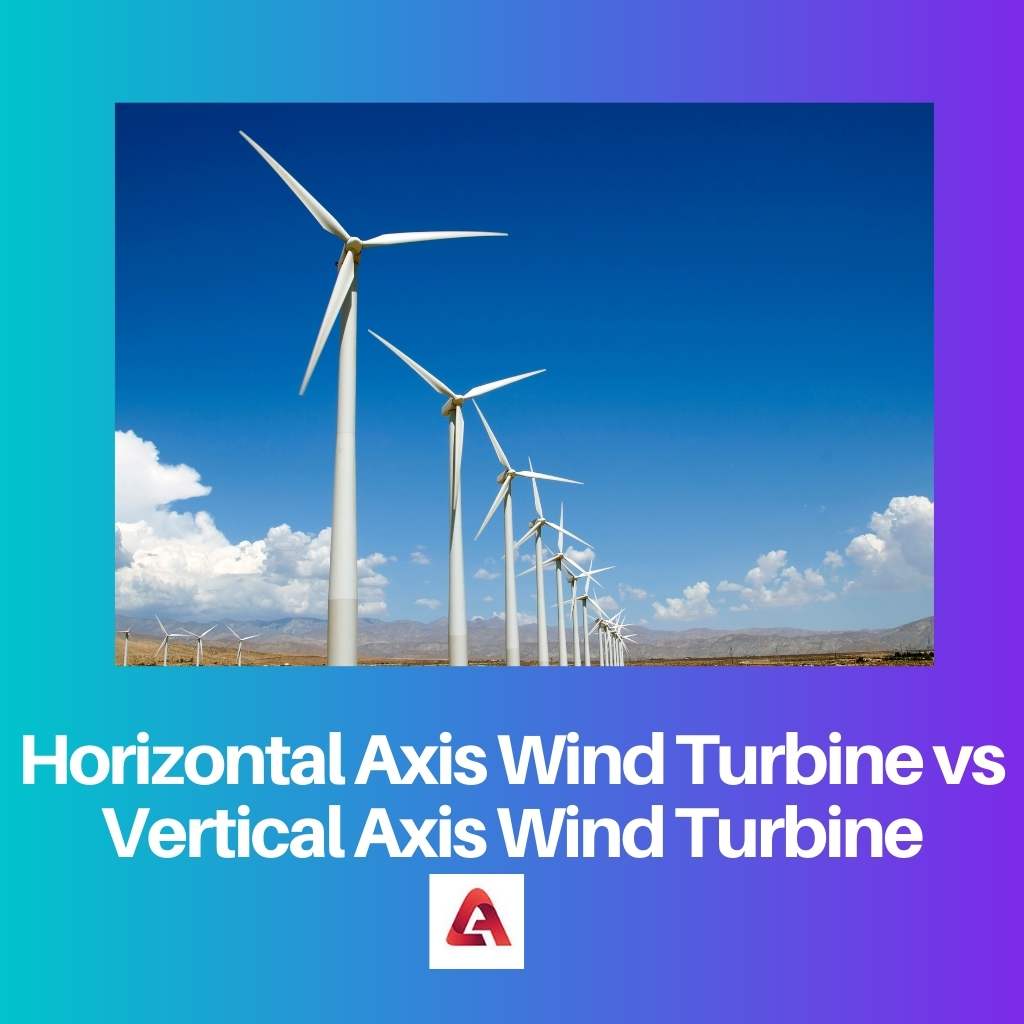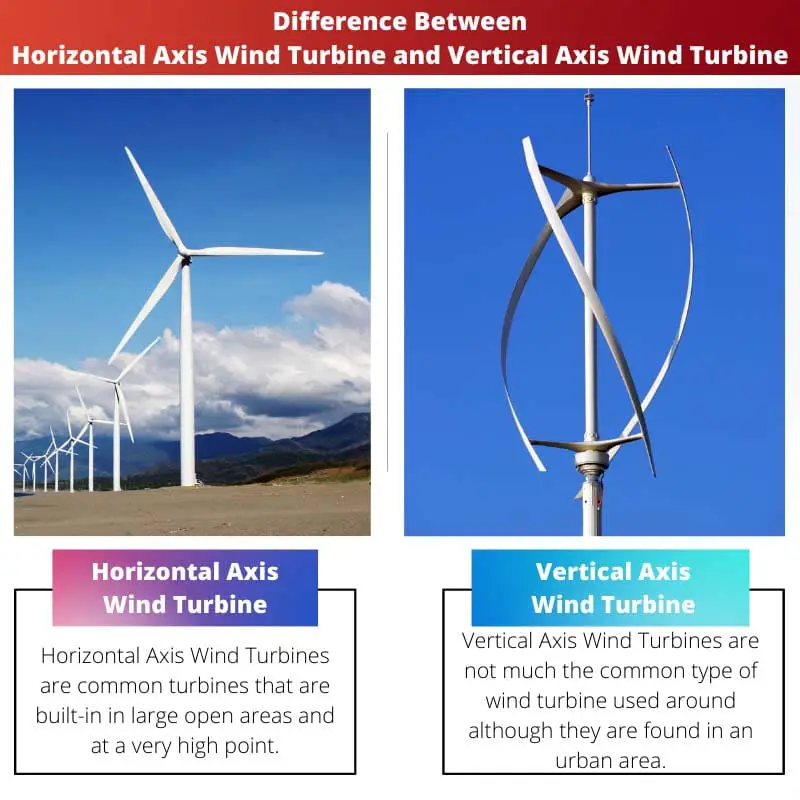A wind turbine is a man-made technology that is used to alter the energy created by the winds into mechanical or electrical energy.
These turbines have numerous uses depending on the size of the blades the short blades can be used to power traffic signals, to run boats, etc, while the turbines with longer blades can be used for domestic supply, also, it is one of the most common renewable resources of energy.
Key Takeaways
- Horizontal axis wind turbines (HAWTs) have a horizontal rotor shaft, while vertical axis wind turbines (VAWTs) have a vertical rotor shaft.
- HAWTs are more efficient and widely used, while VAWTs can capture wind from any direction without reorienting themselves.
- VAWTs are quieter and have lower installation heights, making them suitable for urban environments.
Horizontal Axis Wind Turbine vs Vertical Axis Wind Turbine
Horizontal axis wind turbines (HAWTs), the most commonly used, have a horizontal axis and have two or three blades that rotate around a horizontal shaft. Vertical axis wind turbines (VAWTs) have a vertical axis and can have two or more blades that rotate around a vertical shaft.

Horizontal Axis Wind Turbine is mainly found near urban areas and generates approximately 100kW of energy for residential or daily use purposes.
The blade of these wind turbines is placed accordingly so that the wind’s direction and the blades’ position appear to be parallel.
However, the maintenance of these wind turbines is very difficult, but the blades can run even in medium wind conditions.
Vertical Axis Wind Turbine is not many common types of wind turbines that are found, but despite this, the energy production is much sufficient for some daily work purposes.
The blades in the vertical axis wind turbine are placed accordingly so that the direction of the wind and the position of the vertical blades are perpendicular to each other. Also, unlike horizontal axis wind turbines, the maintenance of the turbine is easy.
Comparison Table
| Parameters of Comparison | Horizontal Axis Wind Turbine | Vertical Axis Wind Turbine |
|---|---|---|
| Acronym Used | HAWT | VAWT |
| Rotating Axis | The position of the blades towards the wind is parallel | The position of the blades towards the wind is perpendicular |
| Rotor Shifts | Horizontal direction | Vertical direction |
| The face of rotor shift | Towards the wind | In any direction |
| Maintenance | Difficult | Easy |
| Power Consumption | More | Less |
| Efficiency | More | Less |
| Used in Places | A place with the streamlined wind condition | A place with turbulent wind condition |
| Operating Condition | Medium wind conditions | Low wind conditions |
What is Horizontal Axis Wind Turbine?
Horizontal Axis Wind Turbines are common turbines that are built-in in large open areas and at a very high points. This is due to the continuous receiving flow of the wind.
The wind turbine consists of the blades in such a manner that they appear to be parallel with the direction of the wind. And so the face of the rotor shifts in the horizontal direction.
The main components comprising the wind turbine are – brakes, hub, blades, nacelle, power transmission system, yaw control, generator, and tower. The noise production is also very low. And these turbines can be operated in medium wind conditions also.
The tower’s construction must be strong, and installing a single horizontal axis wind turbine is very costly. Also, the reason behind such a huge cost involves the complexity of its design, where the motor and the gearbox are installed over the top.

What is Vertical Axis Wind Turbine?
Vertical Axis Wind Turbines are not the common type of wind turbine used around, although they are found in urban areas and produce energy that can be much sufficient for a house to run.
The wind turbines can be expressed in the abbreviation called VAWT and are also called cross-wind axis machines.
This is so because of the presence of the blades in the direction of the wind, and it appears to be perpendicular, which allows the wind to flow from any direction.
The above condition is the biggest flex in the wind turbine as it substitutes the application of the yawing system in the vertical turbine.
The support structure, the long tower, and the vertical blades all are the necessary components to build a vertical turbine.
The tower’s structure is very easy to build and very light in shape. The cost for a single vertical axis wind tower is cheap. And thus, it involves very little maintenance quality.

Main Differences Between Horizontal Axis Wind Turbine and Vertical Axis Wind Turbine
- The acronym commonly known for Horizontal Axis Wind Turbine is ‘HAWT’ while comparatively, on the other hand, the acronym or abbreviation used in place of Vertical Axis Wind Turbine is ‘VAWT’.
- The rotating axis of the horizontal turbine is built in such a way that the wind direction and the position of blades appear to be parallel while comparatively, on the other hand, the rotating axis of the vertical turbine is also built in such a way that the wind direction and the position of the blades appear to be perpendicular in direction.
- The direction of the rotor shifts in the horizontal turbine is the same as its name, i.e. horizontal while comparatively, on the other hand, the direction of the rotor shifts in the vertical axis wind turbine is in the vertical direction.
- In the horizontal axis wind turbine, the face of the rotor shifts is placed towards the wind direction while comparatively, on the other hand, in the vertical axis wind turbine, the face of the rotor shifts is placed in any direction.
- The maintenance of the horizontal axis wind turbine is very difficult, while comparatively, on the other hand, the maintenance of the vertical turbine is effortless.
- The power consumption of a horizontal axis wind turbine is more while comparatively, on the other hand, the power composition of the vertical axis wind turbine is to a lesser extent.
- The efficiency of the horizontal axis wind turbine is much greater, while comparatively, on the other hand, the efficiency of the vertical axis wind turbine is less.
- The horizontal turbine is mainly used in nearby places where the wind condition is quite streamlined, while comparatively, on the other hand, the Vertical turbine is mainly used in nearby places with wind turbulence.
- The horizontal axis wind turbine can be operated even in medium wind conditions while comparatively, on the other hand, the vertical turbine can also be operated during the time of low wind flow conditions.

References
- https://d1wqtxts1xzle7.cloudfront.net/57615726/IJET_-_Vol._7_4.13_pp._74-80-with-cover-page-v2.pdf?Expires=1639402583&Signature=KZ9ShsMIJf3uWGkUcbH34xSOAEWzUr05~QgiV9eg5xmUb~cUJQzjdb7qrlrP1T2sPcIH~2hlO64xtknf9Yctlp71UcH9cMp~wqLEigkTIB1CECgbil2gvf75Gbat1iMmgaHhAk6t8h0ZQxPZdc1GFAe-1xSYL6i316ojahwpynEqENMeMTbGA38sWVM4GE-11JQtC5qzifXPqoadXFasCcHJOdGQYavImPG1wJ4~sXOs3TT-sUy2f9shlRYe0ETZZ4Z8VYvj9wWJdFBCfhjuXpRQTPW4AuxQiW5oYwoAZwjWrhjohgzWnGXTYknvEfy3BRCRfQD4qSlB-1Uiue1Qqg__&Key-Pair-Id=APKAJLOHF5GGSLRBV4ZA
- https://www.sciencedirect.com/science/article/abs/pii/S0960148109003048
- https://iopscience.iop.org/article/10.1088/1748-3182/5/3/035005/meta
- https://www.sciencedirect.com/science/article/pii/S2090447910000134

The information provided about the differences between horizontal and vertical axis wind turbines was very helpful and well-explained. Thank you for sharing!
The article has presented a balanced perspective on the differences between HAWTs and VAWTs, making valuable contributions to the understanding of wind turbine technology.
The detailed description of the main components of horizontal and vertical axis wind turbines was enlightening. This article is a great source of knowledge on the subject.
I found the comparison table very informative. The clear distinction between HAWTs and VAWTs is presented in a straightforward manner. It’s great to know the pros and cons of each type of turbine.
I agree, Freddie! The depth of the analysis is commendable. Great post!
The references provided at the end of the article further attest to the credibility of the information provided. A well-researched and thorough piece of work.
While the post does a good job at outlining the details of each type of wind turbine, it would have been beneficial to also include some real-world examples or case studies to further illustrate the practical application of this technology.
I understand your point, Keeley. The addition of real-life examples would certainly enhance the overall understanding and applicability of the information shared.